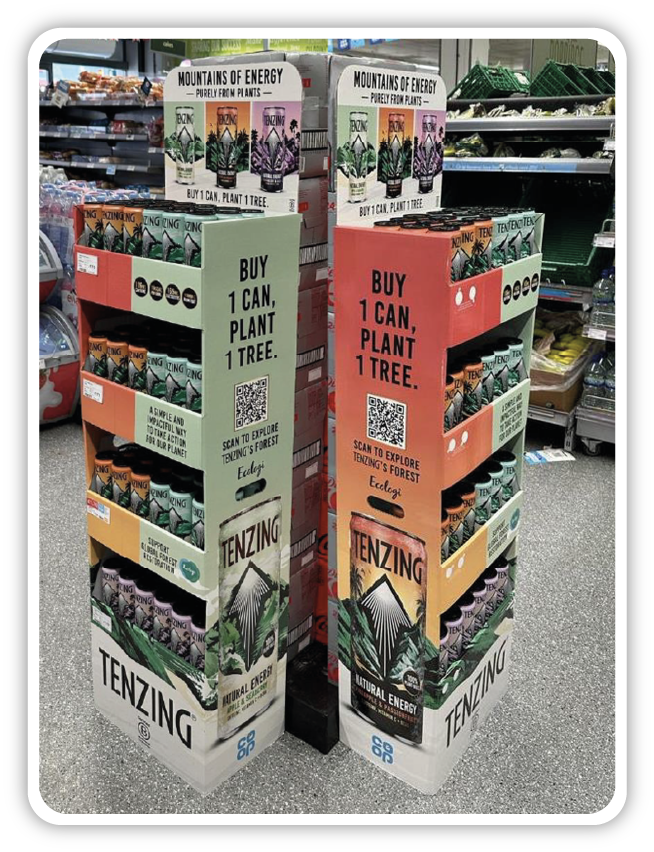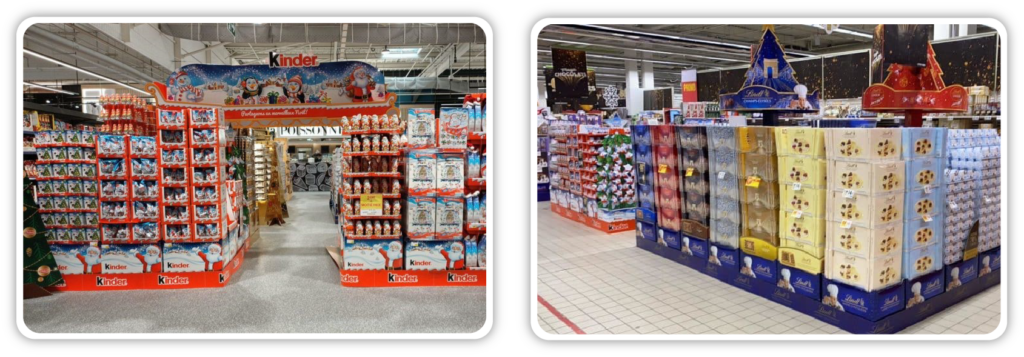Table of Contents
What are the different types of POSM?
There are many types of POSM on the market and they all have different advantages. Here are the most common ones:
Free-standing display units (FSDU)
Freestanding displays refer to an attractive stand-alone display to promote specific products. They can be placed anywhere in the store. They are generally lightweight and adaptable, making them a good tool to efficiently attract customers.


Gondola display
A gondola display usually stands at the end of an aisle. They are often used to display promotions or seasonal products. Gondolas are customisable, so they can be a good option for FMCG brands to display their products and increase their visibility.
Counter displays unit (CDU)
A counter display/cash register display is usually located on or near the counter of a store. This is a strategic area because every consumer buying a product passes through this area, making the products highly visible. They are ideal for smaller products and encourage impulse purchases. It does not matter here whether it is a manned checkout or a self-scanning checkout.


Shelf talkers
Shelf Talkers are labels placed on store shelves and are a great way to stand out from all the products on the shelf at a lower cost. For example, they can be used to promote a new product, highlight special features or inform consumers about a special promotion. They are also often used to bundle products from a brand into a brand block.
Floor stickers
Floor stickers are (often large) stickers placed on the floor to attract customers’ attention. They can be placed in certain store areas to lead customers to the products or directly at the relevant shelf to attract attention.

What’s the difference between POS and POP?
POS and POP are often used interchangeably. Yet there is an important difference:
• POS (Point of Sales) displays are usually located near the products in the store, but not necessarily at the checkout. These displays are often used to promote specific products and encourage customers to make a purchase as they walk through the store. They can be placed anywhere in the store, for example in aisles or near product displays. Examples include stand-alone racks, shelves or signs.
• POP (Point of Purchase) displays are located at the checkout or checkout point, i.e. exactly where the customer pays. They are usually used for impulse purchases, such as sweets, chewing gum or small products that customers can quickly grab while waiting to checkout. The purpose of POP displays is to use the last chance to tempt a customer to make a purchase.
What are the benefits of POSM?
Attract customers’ attention & boost brand awareness
Competition on supermarket shelves is fierce and consumers can choose from a wide range of products. An effective use of POSM can help you stand out on the shelf by making your products highly visible to consumers and stand out from competitors.
Inform customers about your promotions
How do you make sure your offers and promotions are visible to consumers? Through strategic placement, eye-catching design and a clear message, POSM ensures that your promotions are noticed by consumers and that your promotional period is a success.
Drive sales & impulse buying
This is one of the key benefits of POSM because it helps your brand stand out in the eyes of consumers who didn’t initially think of your products. Strategically placed, it can encourage impulse purchases and boost your sales.
A good example of POSM
Over the years, our Roamlers have spotted or even built a variety of POS Materials in-store. A very nice and comprehensive example is the following: the Ferrero campaign for Christmas chocolate. It cleverly combines the seasonality of the Christmas season, huge displays and a strategic location in the central aisle. The chances of missing something are low!

The Ferrero display consisted of large and eye-catching units in the shape of Christmas trees, filled with various Ferrero products. The central aisle maximised product visibility and made it easy for shoppers to grab a box of chocolates. This is a perfect example of a POSM combining seasonal merchandising, strategic placement and attractive POSM to boost visibility and sales during the Christmas season.
Ensure the compliance of your POSM with Roamler
Setting up POSM in-store is the first step towards increasing sales. But to get the most out of your investment, you need to ensure the compliance of your displays over time. What does your in-store POSM look like right now? Are your displays properly stocked with your products? Are your promotions set up correctly?
With Roamler, you can easily monitor and ensure compliance of your POSM in real time. Using our on-demand community, we can monitor the condition and placement of your POSM and verify that displays are correctly set up, stocked and maintained in good condition. We provide detailed reports with photos, compliance scores and actionable feedback to ensure your POSM remains impactful throughout its lifecycle.
